The small, private liberal arts school is among just 13 colleges in the country to achieve net-zero so far.
Catawba College, a tiny liberal arts school 40 miles northeast of Charlotte, just announced a big milestone: its carbon footprint is now zero.
The private college becomes the first campus in the Southeast and the 13th in the country to achieve the target, according to the nonprofit Second Nature, which tracks and verifies schools aiming to zero out their carbon emissions.
At a ceremony Thursday that included Gov. Roy Cooper, officials also highlighted the timing of the achievement, well ahead of its 2030 goal.
“Seven years early shows that it can be done, and it can be done well and rapidly,” Cooper said. “I wanted to be here to celebrate with you today because this is the kind of leadership that we see in North Carolina and that we need right now.”
Over 400 higher-education institutions have made net-zero climate commitments, including over a dozen in North Carolina. But decarbonizing a college campus — even a small one of 1,200 students — is a gargantuan task.
“It’s an aggressive goal,” Tim Carter, president of Second Nature, told the Energy News Network. “It’s hard to do, and that’s why we celebrate.”
The feat involves eliminating or offsetting fossil fuels burned on campus for heating, cooking, and on-campus transportation. Catawba had a head start with a geothermal heating and cooling technology it installed in the 1990s.
“It was an act of incredible foresight,” said Brad Ives, director of the school’s Center for the Environment.
The campus also had to create or buy enough credits for carbon-free electrons to equal the college’s electricity use. It got part of the way there in 2015 with 800 kilowatts of rooftop solar panels and 76 solar thermal modules. It also implemented energy efficiency measures, including building 20,000 square feet of ultra-efficient LEED certified buildings.
“All of these made a big difference,” Ives said. “Our per-full-time-student emissions are less than half of those at Duke University or the University of North Carolina,” he added, eliciting laughs and applause from the partisan crowd.
Perhaps most daunting, Ives and his team had to zero out all ancillary emissions caused by the school, including those further up its supply chain and airplane travel for activities such as — officials noted with pride — the women’s basketball team competing in this year’s Division II Final Four.
“They’re not hydrogen jets yet,” said Ives, of technology that’s a decade away, at best. “It’s very hard to produce zero emissions.”
To make up for the pollution it couldn’t eliminate on campus itself, Catawba officials bought renewable energy credits from two North Carolina solar farms, as well as a project in Buncombe County that captures methane, a potent greenhouse gas, from a public landfill.
While offsets have been criticized for their limitations, Ives said the school was “very deliberate” about choosing projects in North Carolina. “We could have gone for much cheaper offsets that did not impact our neighborhoods and our state.”
Even so, Ives stresses that purchasing the credits and offsets cost the school less than $100,000 a year, and that Catawba’s model is a replicable one. That’s especially true for institutions in cities or states with their own carbon neutral targets, said Second Nature’s Carter.
And though Carter says higher education overall only accounts for 3% of the country’s carbon emissions, the effect of campuses taking action extends beyond their footprints.
“You lose credibility if you don’t practice what you teach,” he said.
Based in Raleigh, North Carolina, Elizabeth Ouzts has covered the state’s clean energy transition for the Energy News Network since 2016. This story originally appeared in Energy News and is republished here as part of Covering Climate Now, a global journalism collaboration strengthening coverage of the climate story.






